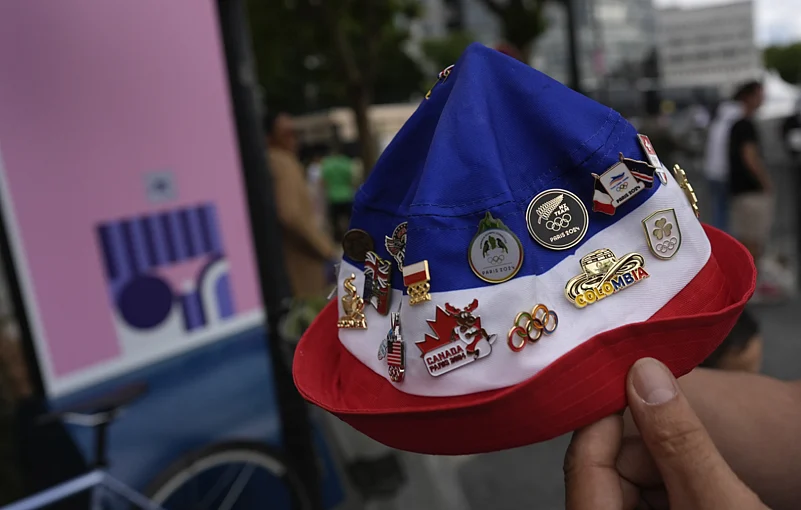Pin trading at the Olympics is more than just a pastime—it’s a vibrant tradition steeped in history and excitement. This year, the Paris Olympics have taken this tradition to new heights with an unexpected celebrity twist: a Snoop Dogg pin that has collectors and fans buzzing.
What’s The Buzz About Pin Trading At The Paris Olympics?2024?
Pin trading has surged in popularity, particularly on TikTok, where athletes and collectors share their finds.

So What Is Pin Trading?
Pin trading is a olympic tradition where athletes, fans, and collectors exchange small, collectable badges adorned with Olympic themes. These pins are not just souvenirs; they often represent various countries, sports, and special events, creating a colourful tapestry of Olympic memorabilia.
Buzz Around Snoop Dogg’s Pin
This year’s standout collectible is undoubtedly Snoop Dogg’s Olympic pin. As an NBC Olympics special correspondent and a cultural icon, Snoop Dogg’s pin features the rapper in a distinctive pose, blowing smoke rings that take the shape of the Olympic rings. This eye-catching design has quickly become the pin to own.
Tennis star Coco Gauff, who recently received one of these coveted pins directly from Snoop Dogg, shared her enthusiasm in a heartfelt video. “Hey Mr. Snoop, thank you for this pin. This pin is the best pin that I’ve ever gotten. And I hope to see you at the US Open, or maybe I hear you may come Wednesday to watch us play again. So, thank you for the pin, and I’ll see you at the next one,” she said. Her excitement reflects just how much these pins mean to the athletes and fans alike.
While pin trading itself is not new, it has recently gone viral on TikTok. Athletes and collectors are sharing their pin hunts, showcasing their collections, and turning the search for rare pins into engaging content. This social media buzz has amplified the excitement surrounding pin trading, making it a key part of the Olympic experience.
'Unofficial Sport Of The Olympics'
Pin trading has earned the title of the "unofficial sport of the Olympics." According to pin enthusiast Ed Schneider, there could be millions of different pins in circulation. Each participating country issues exclusive pins that athletes trade among themselves, with coaches, volunteers, and even with collectors. Spectators also join in the fun, making pin trading a global phenomenon.
For larger teams, individual sports often have their own special pins, and high-profile athletes like Simone Biles contribute their own designs, making these pins especially sought after by collectors.
And yes, the excitement surrounding pin trading has taken Paris by storm. In Paris, the question “Do you have any pins?” is frequently asked, whether you’re grabbing a coffee at the Palais des Congrès, the main press centre, or simply wandering through the city, reported AP.
How Did It All Begin?
The tradition of pin trading dates back to the revival of the modern Olympics by Pierre de Coubertin in 1896. Initially, simple cardboard badges were used for identification. Over the decades, these badges have evolved into highly detailed and intricate pins that often incorporate advanced technology and unique designs tailored to the participating countries and events.
The Los Angeles 1984 Olympics were a turning point for pin trading, introducing a wide array of pins including media, sponsor, athlete, and mascot designs. This diversification sparked a public frenzy, cementing pin trading as a beloved Olympic tradition.
The Paris 2024 Games mark a resurgence of pin trading after two Olympics held without spectators due to the pandemic. “Paris has been very good for pin collecting because after the pandemic, where you could not trade pins so much in Tokyo and Beijing, people are very excited,” explains Nicholas Wolaver, an American collector to AP.
Social media has played a significant role in boosting the popularity of pin trading. Former Olympian Serena Williams, for example, has shared her own collection on Instagram, revealing her favourites and adding to the buzz. Andy Murray, who recently retired, has also been actively involved in trading, searching high and low for rare pins, including one from Liechtenstein.
What makes pin trading so appealing is its inclusiveness and accessibility. Unlike the official Olympic events, which are limited to stadiums, pin trading happens everywhere—on the streets, in cafés, and even online. Traders and collectors proudly display their pins on their clothes, creating a dazzling array of colours and designs that attract attention and spark conversations.
From exchanging pins with fellow collectors to interacting with high-profile figures like French President Emmanuel Macron and International Olympic Committee President Thomas Bach, the stories behind the pins are as varied and intriguing as the designs themselves.
- Previous Story
 US Elections 2024: Tim Walz, JD Vance To Go Head-To-Head In VP Debate | Key Issues To Watch Out For
US Elections 2024: Tim Walz, JD Vance To Go Head-To-Head In VP Debate | Key Issues To Watch Out For - Next Story


























